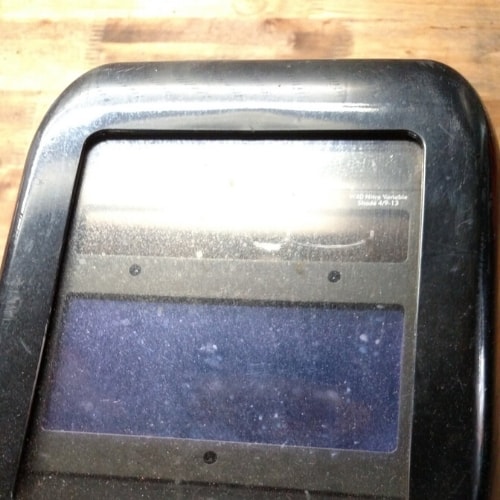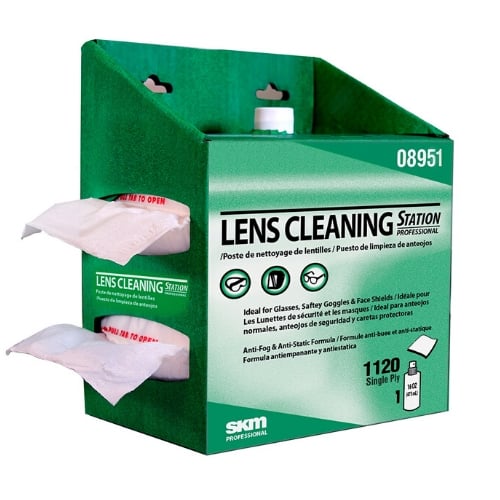It is fair to say that there is no piece of welding safety equipment that is more recognizable or essential than a welding helmet.
Whether you are a master welder, a hobbyist, or just starting out, chances are you recognize a welding helmet and likewise recognize just how important it is from a safety perspective to know how to clean your welding helmet lens.
No one wants to think about the heat and sparks generated from welding flying up and hitting them in the face.
How to properly clean your welding helmet lens? You want to make sure that you clean it as gently as possible with anti-static with UV protectant lens cleaning microfiber towel and you can also use cleaning spray, however, you need to make sure you do not scratch the sensitive lens.
Follow these basic steps to make sure you get it right.
| Steps | What to do |
|---|---|
| 1 | remove debris with a brush |
| 2 | check the helmet |
| 3 | disinfect the lens surface |
| 4 | wipe Off |
| 5 | dry the helmet |
| 6 | check the functionality |
Table of Contents
How to Clean a Welding Helmet?
To clean a welding helmet, you will need a soft cloth or tissues, wet wipes, plain room temperature water, a smooth bristled brush, and a special helmet cleaning solution that’s safe for lenses.
The cleaning process involves nine steps, starting with the lens, which is the dirtiest part, and then inspecting and wiping off any dirt and grease from the rest of the helmet.
Welders know that the lenses of welding helmets get dirty easily due to dust, weld smoke, weld spatter, and scratches, and there are several ways to clean the lens. It’s important to clean the lens gently and with precautions to avoid scratching it.
Using an anti-static with UV protectant lens cleaning microfiber towel is recommended. However, it is not safe to weld in a basement, as there is typically not enough proper ventilation, and the risk of fire is increased. It is best to find a safer location for welding tasks and follow safety measures to prevent accidents.
Can You Wash a Welding Helmet?
Washing a welding helmet is not recommended, as it can damage the helmet and the lens. However, regular cleaning is necessary to ensure the helmet’s longevity and safety.
To clean a welding helmet, use a soft-bristled brush to remove dust and dirt from all components, including vents. The lens can be cleaned using a special cleaning solution safe for lenses, a soft cloth, wet wipes, and a smooth bristled brush.
You can dab a few drops of rubbing compound on the lens and wipe gently with a terry cloth or microfiber cloth to restore and prolong its life. It’s important to be gentle and cautious while cleaning the lens to avoid scratching it.
How Often Should I Change My Welding Lens?
The frequency with which you should change your welding lens depends on how frequently you use it and the condition of the lens.
A good rule of thumb is to replace your welding lens every six months to a year, or as soon as you notice any cracks, scratches, or discoloration that cannot be removed by cleaning.
It is also important to replace the lens if it becomes warped or damaged in any way, as this can compromise its ability to protect your eyes from harmful UV radiation and infrared light.
Remember that a damaged lens can lead to serious eye injuries, so always err on the side of caution when it comes to replacing your welding lens.
Can I clean Helmet Visor With Alcohol?
It is not recommended to clean a welding helmet lens with alcohol or ammonia-based cleaners. These cleaners can damage the lens, leaving behind scratches and discoloration that can affect vision and safety. Instead, you can use a thin microfiber towel or lens cloth to gently wipe the lens after removing any debris with a brush.
If the lens is coated or has a thin film, it should be cleaned carefully to avoid damaging the coating. Proper cleaning and regular maintenance can extend the life of the lens and ensure clear vision while welding.
It is also important to replace the welding lens every six months to a year or as soon as any damage or discoloration is noticed to prevent eye injuries
A Couple of Precautionary Notes
Those sparks, that heat, and all the soot, ash, and particulates they kick up can leave your welding helmet’s lens dirty. You cannot weld if you cannot see what you’re welding, so finding a way to keep that lens clean and, thus, your vision clear while welding is essential.
While you need to clean your helmet lens, you need to make sure that you don’t damage it in the process. With that in mind, you’ll need to take a few basic precautionary steps:
- Despite the fact that welding helmets are quite sturdy, the lenses can be surprisingly delicate. As such, you don’t want to hold the middle of it. Instead, you’ll want to hold it gently by the edges.

- Be very careful when cleaning your lenses with cleaner. Even a light spritz of cleaner and pressure from your towel and hand can be enough to scratch them
Step 1: Smooth the Lens with a Brush
You don’t want to jump right into the cleaning process. Instead, you want to start a bit lighter and brush away any loose debris with a brush.
You do this so as to make sure that you don’t accidentally scratch the lenses. While you’re there, you might also want to brush any loose debris away from the vents and inner part of the helmet.
How to Clean Welding Lenses >> Tutorial Video
Step 2: Review its Condition
Think you’re ready to start cleaning the lens now?
Think again.
Before you do that, you’ll want to take a closer look at the helmet to review its overall condition. You don’t want to go through all the trouble of cleaning it only to miss some other flaw in the helmet.
For example, all those sparks may have taken their toll and your helmet is starting to weaken in a few places.
Maybe in the course of work, one of the screws has started to come loose. Or maybe your lens is already cracked. These are all obviously the kind of flaws you want to detect before you put your helmet on for welding, so look for them while cleaning it.
Step 3: Disinfect Your Helmet
Ready now?
Not so fast.
It can get hot and sweaty in your helmet while you’re in “the heat of the moment” working on a welding task, and that heat and moisture don’t just go away.
A buildup of moisture is unpleasant itself, but it can also create the perfect breeding ground for germs.
Neither are good for lens visibility or your overall health and safety while wearing the helmet. As such, you’ll want to take this opportunity to disinfect it.
Look through different options online for disinfectants that are strong enough to tackle germs without falling into the same trap of being too strong for the lens itself.

Step 4: Wipe Off the Surface
OK, now you’re finally ready to start cleaning your helmet.
Different aspects of your helmet lens will need different amounts of attention. For example, the helmet shell itself should be pretty sturdy, so you shouldn’t need to give it too much extra care.
- By contrast, the auto darkening part of your lens is one of the most sensitive, and not something you want to scratch. You, therefore, want to make sure that you clean it as gently as possible with an anti-static with UV protectant lens cleaning microfiber towel. Press very gently and work very slowly and smoothly.
Step 5: Dry Your Helmet
If you notice any leftover moisture on the lens, do not let it simply set there. You don’t want it dotting the lens. Instead, you should absorb it. A kitchen or bathroom towel can work fine for this process, but once again, be extremely gentle.
These towels are likely thicker and rougher than what you used to clean the lens with. Don’t use them for extra wiping, but just for a little extra absorption if necessary.
Step 6: Final Inspection and Tips
Before you put your helmet away, take some time to review its condition. As stated, lenses can be very delicate, so still grab it by the edges only.
Different helmets might require specialized cleaning procedures. So, read your helmet’s user manual before cleaning your helmet.
A few other tips to keep in mind while cleaning your lens:
- If your welding helmet is battery powered, remove the batteries before cleaning it.
- If the welding helmet is solar powered, you need to be even more gentle when dealing with it, as these are especially sensitive to light and heat.
- If your helmet’s lens is multilayered, you should remove each section and clean them all separately. Once again, be very gentle in removing and replacing each layer.
There is a lot more to cleaning your welding helmet’s lens than you might imagine. What’s more, for such a durable piece of equipment in such a tough industry, you may be surprised with how gentle you have to be.
That said, you don’t want to deal with the consequences of handling it roughly.
By following this guide for how to clean a welding helmet lens, you can keep it in good shape for years to come.
Recommended Reading
Do Welders Get Drug Tested? | All Facts You Need To Know
Does Welding Hurt Your Eyes? How Can You Protect Your Eyes
How to Adjust an Auto Darkening Welding Helmet: A Quick Guide

